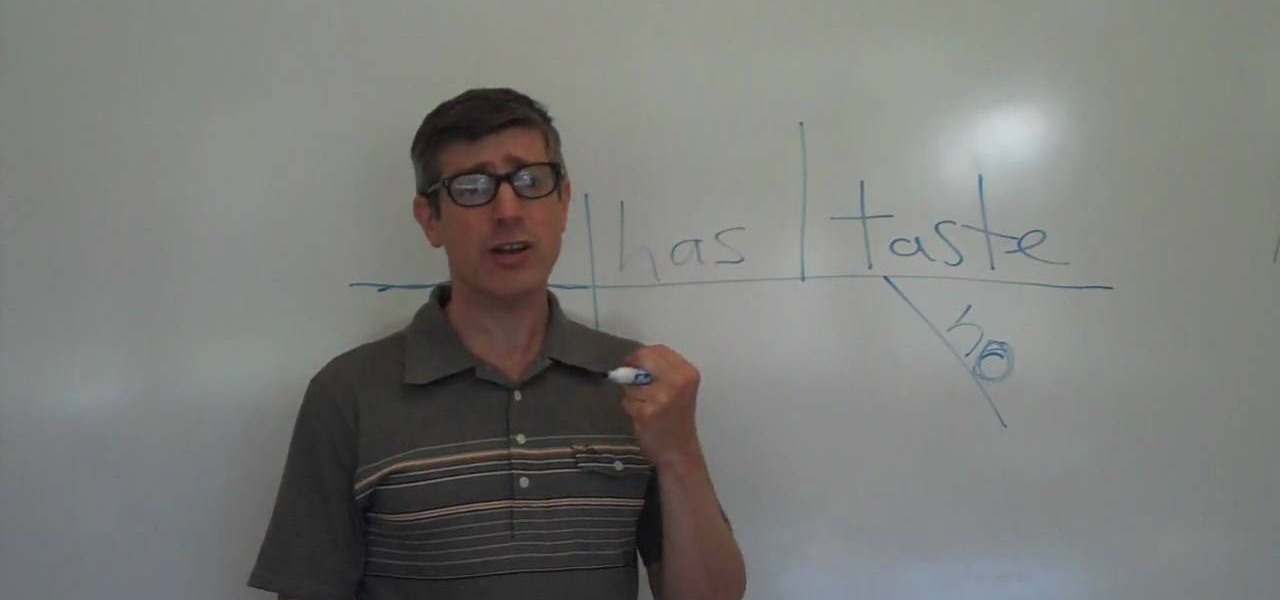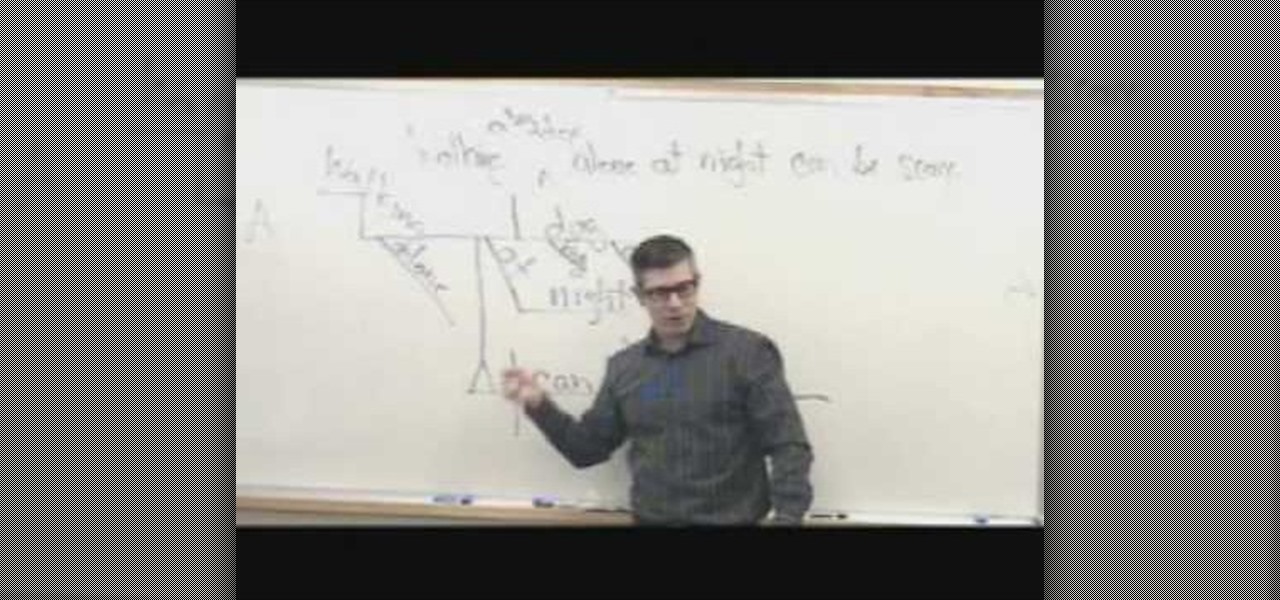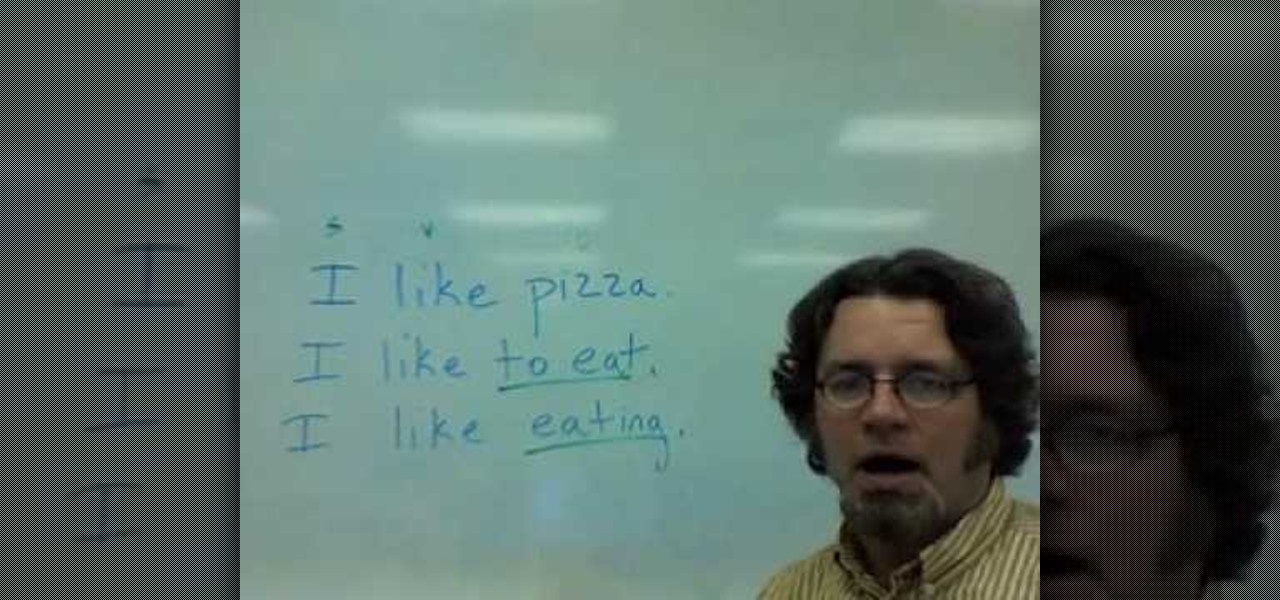Hot English Language & Culture Posts


How To: Describe problems in English
This video tutorial is in the Language category which will show you how to describe problems in English. When describing problems in English, many people use the word trouble. When you frame a question, you can frame it in the present or the present continuous tense. For example; what do you have trouble with or what are you having trouble with? Similarly, when you answer the question you can use the present or the present continuous tense. Examples of this are; I have trouble with my car or ...

How To: Describe solutions in English
In this video, we practice describing solutions in English. For example, if the problem is that you have stomach problems, the solution is that you should go to the doctor. Should simply means a good idea or a recommendation. You could also say the solution is that you need to go to a doctor. For the next example, if your problem is that your car won't start, this means your car will not start. You could also say that your car does not start, which is a good way to describe the problem. For t...

How To: Use the definite article for generic nouns in English
If you're trying to learn how to speak and understand the English language this video should help in one area: generic nouns. This is an easy subject that anybody can pick up on.

How To: Parse a sentence in English
It's time for another great grammar lesson with the Grammarian, Yossarian! In this tutorial, you'll actually be attempting to test your abilities and have to parse a sentence.

How To: Diagram the nominal clause as the subject
If you need help with creating a sentence diagram and need help with it for homework or just because, this tutorial is sure to help. In the video, you'll be finding out how to create a diagram for the nominal clause as the subject.

How To: Diagram a nominal clause as direct object
Learning English may seem like fun, but it's not. It's one of the hardest languages to learn, because there are so many different ways that sentences can be created. So it's important when learning the language, to understand the grammar behind it.

How To: Use gerunds in the passive voice in American English
In this clip, an English teacher shows how to use gerunds in the passive voice. It's easier than you might think! It's so easy, in fact, that this free video English lesson can present a complete, detailed overview of passive voice gerunds in just over three minutes. For more information, and to get started improving your own English, take a look.

How To: Pronounce the alphabet correctly in English
This video will show you how to pronounce the alphabet correctly in English. If you have trouble hearing the correct pronunciation, and telling the difference between "c" and "d" and "b", this video helps you out with clear enunciation of each letter. Watch this video to pronounce each English letter correctly.

How To: Use "make" as a causative verb in American English
An online English teacher explains to English-language learners how to correctly use the word "make" as a causative verb in this instructional video. As usual, he provides many examples to in order to make the contextual usage of this important verb more clear to those attempting to learn American English for work or pleasure.

How To: Use the phrase "go shopping" in American English
Learning proper American English usage is a challenge, but fortunately this video is here to explain the usage of one common phrase to the non-native English learner. That phrase, one near and dear to the hearts of Americans, is "go shopping". This simple instructional video point out common mistakes that English learners make and shows how to use the phrase correctly in context.

How To: Distinguish between all of the English color idioms
Do you know what an idiom is? If you don't, this English lesson is sure to make you an expert on idiom usage.

How To: Use articles in the English language
An two part introduction or overview of English articles: a, an, the, and the zero article. This is for the advanced or intermediate student. Part one presents basic rules or guidelines for using English articles. Part two summarizes the basic rules for using English articles and offers practice.

How To: Use the word 'got' in the English language
In this video it is explained how to use the words "got" "got to" and "gotta'". "Got" is the past tense of the word " get". Sometimes Americans say "have got" in place of "have" or "got" in place of "have". For example there is a sentence "I've got my wallet". Some Americans say "I have my wallet" and some may say "I got my wallet". All of them are correct. "Gotta'" is used in place of "have got to". For example there is a sentence" I have got to go". Some Americans may say

How To: Use double comparatives in the English language
This is a tutorial segment of Double comparatives of English Grammar. In this lesson, the instructor is explaining about how to express a cause and an effect in a easier way with examples. She says that it’s the relationship where one thing makes a change on another or one factor say for example sunshine, produce a result in another by making us to feel happy. Comparative forms are used to express a cause and effect. Words like brighter, happier are examples for that. For example, in the sent...

How To: Use the 'stop' verb in the English language
The verb "stop" in the English language can be used with a gerund and an infinitive. The word "stop" has different meanings depending on how it's used. Look at the sentence, "I stopped eating fast food." Stopped is used in the past tense and eating is a gerund, or a word that describes an activity and functions as a noun. Look at the sentence, "I stopped to eat some fast food." In that sentence, there is an infinitive. The first sentence means I no longer eat fast food. The second sentence me...

How To: Say seven key Gaelic phrases
The best way to win friends over in a foreign country is by breaking the ice and showing your enthusiasm with your best effort at their language. Practice your Gaelic for travel or just for fun with friends.

How To: Put on a convincing Irish accent
Accents are not only fun but attractive too, when done properly, at least. Work on your Irish accent, practicing the inflection and sound of consonants and vowels. Impress your friends with your new accent.

How To: Rhyme
From nursery rhymes, to rap songs, to love poems, rhyming is an important part of the English language. If you're feeling a little shaky on your rhyming abilities, glance over some of these simple rules and you'll be off and rhyming again.

How To: Use the future perfect tense in English easily
The future perfect tense describes a situation which is finished in the future. This video tells us how we can use future perfect tense easily. It gives us a deep insight through the grammatical aspect of future perfect tense. It shows us how to use the helping verb i.e "will" with the third form of verb to form a statement in future perfect tense. the basic formula for making a correct statement in future perfect tense is "subject + helping verb + past participle (v3). It's easy to remember ...

How To: Diagram gerunds & gerund phases
For those who don't know, a gerund is a noun whose root word is formed from a verb. Anyone interested in brushing up on their grammar skills should view this video by Yossarian on how to diagram gerunds and gerund phrases. Yossarian uses various sentence examples to break down the subjects and verbs to find gerunds and gerund phrases. Learn how to break down the components of any sentence to find the gerund and gerund phrases by following this video tutorial.

How To: Pronounce the English /r/
If you are learning the English language make sure to follow this video which can better explain to you how to pronounce the letter R. When speaking in the English language we may often make common errors on how to pronounce the letter R in the words we use. One tip to pronounce the letter r better is not to touch the top of our mouth with our tongue when saying the letter r. Secondly, you have to make your lips shape in a tightly rounded manner to say the letter r accurately. You could also ...

How To: Practice saying the "t" sound in the middle of words
In words like bottle and mitten, the "t" really isn't a "t" sound; it is more of a "d" sound or a very fast "t" sound. Practice the "t" sound with the words button, carton, brighten, tighten, fatten, eaten, rotten, matter, butter, flutter, water, bottle, settle, and metal. In American English, the "t" sound is very difficult to hear in some words. An example of this is the word butter, where the "t" sounds more like a "d." Remember, the way people speak English in the United States is differe...

How To: Use present tense & present perfect tense in English
In this two part tutorial an English teacher shows some differences between the present tense and the present perfect tense. You will learn the basics, in how to ask a proper question. Watching this will allow you a little more understanding of the English language and how to use it.

How to Speak English: Verb "be" in the present tense
ESL teacher Jennifer Lebedev teaches the proper usage of the English verb 'be' in the present tense. The verb 'be' has three forms in the present tense: 'am', 'is', 'are'. Sentences are formed with a subject and a verb. To make sentences with the verb 'be', use the correct form with the subject. Subjects are nouns and pronouns (people, places and things). Use 'am' for the pronoun 'I', e.g. 'I am hungry. 'Use 'is' for singular nouns (one thing) and the pronouns 'he', 'she', 'it', 'this', e.g. ...

How To: Describe situations that didn't happen in the past
This video shows us how to describe the situations that are opposite of the future perfect tense. Here it is shown how to describe the situations that did or did not happen in the past using would, have and past participle. He gives us 3 very good examples that are describing such situations. In these examples he describes a situation which happened in the past which is actually a negative and uses a fact that is described in the present tense to give the reason why that situation ended in a ...

How To: Ask "How do you like your job?" in English
This video teaches English-language learners how to respond to questions beginning with the words "How do you like". There are two types of questions in English that begin with the words "How do you like". The first kind requires an answer in the form of an opinion. The second requires that the answer come in the form of giving instructions. The video explains the difference, then gives several examples for each to model practice. For example, "How do you like the weather?" is a question whic...

How To: Use the word "like" properly in English
This how to video describes how to properly use the word "like." Since "like" is one of the most misused words in the English language this is great for anyone who is not an English professor. The author begins by describing what types of words you can use the word "like" with and then he presents numerous examples for its correct usage. The video itself will only take about two and a half minuets of your time and will greatly improve your speaking skills.

How To: Use count and mass nouns correctly
Mrthoth will show you how to use, count, and mass nouns correctly. Listen to a sample sentence and try to find the grammatical errors in the sentence. A mass noun ca refers to a whole group of objects, for example you would not say a lot of butter you say a lot of butter. A count noun is basically a noun you can count. You can make it plural and you can put a number in front of it. Like you say it was a lot of pencils.

How To: Cite sources in the APA format
In this video, , peakDavid, demonstrates how to use and understand the APA (American Psychological Association) format for citing sources for references in papers, essays, and theses. You will learn the different types of citations used in APA format, and learn to understand how they are used to reference the works you used in your paper. Also, you will learn why you should use the APA format to cite your research, to avoid confusion by the reader, as well as any claims of plagiarism.

How To: Understand English phrasal verbs & compound words
The presenter, Ms. Jennifer explains how compound words are formed from phrasal verbs. With examples she explains how the meaning and pronunciation differs when compound words are formed from phrasal verbs. She explains the difference between 'show' and 'show off' by showing her collection of fans, and showing off with one of her beautiful fan from Japan. Then she explains the difference between 'show off' and 'show-off', giving examples and makes the listeners clear about compound nouns also...

How To: Use expressions with the word "table" in them
In this video, an English lesson for foreign language speakers teaches viewers expressions using the work "table." There are three different expressions taught through watching, listening and defining.

How To: Understand present, past and future tenses in English
This tutorial tells us about using helping verbs with the simple form. It also gives us information on the differences between the present, past and future tenses.

How To: Pronounce OUGH in American English
Learn how to pronounce the OUGH sound in American English. This video language lesson from Rachel's English provides a basic guide for pronunciations for ESL students. Say "ough".

How To: Learn the basic spelling rules of English language
English can be difficult because few words are spelled phonetically, and every rule has exceptions. But you can become a champ in no time by memorizing a few basic rules.

How To: Make the AA sound in American English
Learn how to pronounce the AA sound in American English with this ESL lesson.

How To: Make the AH sound in American English
The ah sound. The jaw drops more on this sound than it does on any other vowel sound. Ah, ah. And as you can see, the tongue is laying there on the bottom of the mouth. Ah. So, the jaw drops here, make the sound, ah: pretty basic, simple, and straightforward. Ah. Sample words: father, collar, calm. Sample sentence: The party at the bar was a mob scene.

How To: Make the W sound in American English
This ESL video explains how to make the W sound, in terms of tongue, jaw, and lip position. This video provides a basic guide for pronunciations for ESL students.

How To: Make the 'ng' sound in American English
Learn how to pronounce the 'ng' sound in American English. This video provides a basic guide for pronunciations for ESL students.

How To: Understand tenses in the English language (for ESL)
An English teacher shows some of the differences between the present tense and the present continuous tense in making statements, negatives, and questions. For ESL students. If you are learning to speak English, watch this video on present tense vs. present continuous tense.

How To: Practice advanced English grammar
Check out this instructional English language video that demonstrates how to improve your English vocabulary skills, your listening skills, and your grammar skills. This is a lesson for the advanced English language learner. The theme is the 2008 Olympic Games that focus on VOCABULARY, LISTENING, and GRAMMAR skills. This is PART THREE, in which we examine and practice several (but not all) verb tenses. Be sure to watch the first two videos. Improve your English vocabulary with this instructio...







